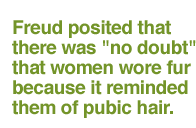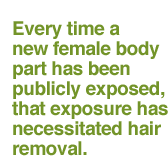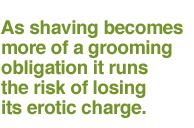|
 |

|

|
Pubic hair is in the midst of an egregious public relations disaster. It was bad enough when a stray strand turned up on Clarence Thomas' Coke can. Now, the ladies on ABC's morning gabfest, "The View," refer to their crotches as their "George Ws." And the bush itself is rapidly becoming a thing of the past, as more and more women are going almost completely hairless.
About a decade ago, those odd rectangular carpet samples, "Charlie Chaplins" or "landing strips" (just above the clit) came into vogue, first among female porn stars. Though the few existing lesbian skin magazines show a  tiny bit more variation, minimal hair tends to prevail there as well. And exotic dancers say shaving is de rigeur in their profession, where hairstyles tend to mirror those in the porn industry. tiny bit more variation, minimal hair tends to prevail there as well. And exotic dancers say shaving is de rigeur in their profession, where hairstyles tend to mirror those in the porn industry.
But these days, this shorn aesthetic afflicts not only the airbrushed and silicon-injected realm of commercialized fantasy, but the real world as well. Cindy Barshop, the owner of Completely Bare, a hair removal spa on Madison Avenue in New York, says of pubic thatches, "They're getting smaller and smaller." While bikini waxes (just the inner leg) have been common for some time, the Brazilian wax in which all the pubic hair is removed except for a rectangular or triangular bit, which is pruned sharply like French garden shrubbery is now trendy among Barshop's clients. Increasingly in demand is the salon's eponymous "Completely Bare" style (a bit of a misnomer as they do leave a little round patch right on top of the mons). Some of the shaving enthusiasts that I interviewed go even further, shaving off everything; two women once trimmed so closely that they actually snipped their clits: "I thought that I would never be able to have an orgasm again," said one, "or even go to the bathroom."
Never have orgasms again? What forces are at work here that would lead otherwise sane people to take such risks with their family jewel?
Human civilization has always held a deep ambivalence toward pubic hair. While hair removal is a relatively new phenomenon in most of the Western world, Turkish, Iranian and Italian women have depilated for centuries, as have women in parts of India and Africa. According to Femina Libido Sexualis, a 1965 medical text with a heavy dose of (not necessarily reliable) anthropology on female sexual characteristics, copious pubic hair has, in parts of Siberia, been considered a "monstrous growth," attributable to evil spirits and legitimate grounds for a husband to divorce his wife. On the other hand, the Aru Islanders of Eastern  Indonesia have worn female pubic hair in amulets around their necks to ward off evil spirits. And in Japan, female hairlessness used to justify annulments. Indonesia have worn female pubic hair in amulets around their necks to ward off evil spirits. And in Japan, female hairlessness used to justify annulments.
In Western culture, pubic hair generally fares better in eras and places where people are more at ease with sex and sensuality. One finds homage after homage to the female bush in French painting, photography and pornography. The painter and Tahitian enthusiast Paul Gaugin saved pubic hairs from all his lovers, and the Romantics seem to have been similarly inclined; Caroline Lamb, the wife of British Prime Minister Lord Melbourne, is said to have sent her lover, the poet Lord Byron, strands from her tangle.
Not surprisingly, the Victorians were consumed with an anxiety about pubic hair that rivaled our current hysteria. Most of their nude paintings hide the crotch, and those that show women in explicit poses tend to leave the hair off. Painting mostly nymphs and goddesses is a convenient way to get around the matter; after all, who knows what they have down there. Such portrayals  must have taken their toll: art critic John Ruskin supposedly never consummated his marriage because he was so appalled by the fur between his wife's legs. Sigmund Freud believed that women were excessively albeit unconsciously preoccupied with their pubic hair, suggesting that their achievements in the weaving arts could perhaps be attributed to unrealized fantasies about plaiting their hairs together to conceal their shameful lack. (When I told my girlfriend about this theory she, in a fit of whimsy, braided mine. Naturally this cheered me up immensely, and my penis envy quickly subsided.) Freud also posited that there was "no doubt" that women wore fur because it reminded them of pubic hair. must have taken their toll: art critic John Ruskin supposedly never consummated his marriage because he was so appalled by the fur between his wife's legs. Sigmund Freud believed that women were excessively albeit unconsciously preoccupied with their pubic hair, suggesting that their achievements in the weaving arts could perhaps be attributed to unrealized fantasies about plaiting their hairs together to conceal their shameful lack. (When I told my girlfriend about this theory she, in a fit of whimsy, braided mine. Naturally this cheered me up immensely, and my penis envy quickly subsided.) Freud also posited that there was "no doubt" that women wore fur because it reminded them of pubic hair.
A few decades later, in the 1950s, Playboy playfully evoked what they dared not show with feather boas that disappeared between models' legs. Marilyn Monroe, cover girl for the December 1953 debut issue, is gleefully billed as "blonde all over." Playboy didn't show crotches regularly until the 70s, and by then the full thatch, in all its chaotic delights, was very much in style. A thoroughly untrimmed Miss October 1972 reclines on a bed of leaves, while Miss May, equally hairy, relaxes on a bearskin rug and talks  about moving to Colorado to get "back to nature." In the '80s Playboys, hair is trimmed, but its natural shape is generally left intact. It's the early '90s when the down there hair mysteriously starts to disappear. about moving to Colorado to get "back to nature." In the '80s Playboys, hair is trimmed, but its natural shape is generally left intact. It's the early '90s when the down there hair mysteriously starts to disappear.
Given the complex but often erotic history of pubes, what accounts for America's pre-millennial obsession with pubic hairlessness?
Kelly Anderson, a zealous hair removal advocate and former exotic dancer, says it makes it easier for lovers to navigate what can otherwise be mystifying terrain. "Some people," she observes, "don't really know what's going on down there. I think the hair only added to the problem. Without hair, everything is visible."
The crotch is quickly becoming the new cleavage. As fitness becomes a moral imperative (especially for women), people who work at it want to show it off more. Bikinis are getting skimpier, and token T & A is a given when it comes to contemporary advertising, art and film. Because female nudity (and now frontal female nudity) is a guaranteed selling point, it's consistently positively reinforced. In her recent book Survival of the Prettiest, Nancy Etcoff points out that throughout history, every time a new female body part has been publicly exposed, that exposure has necessitated hair removal. It's a practice, she explains via evolutionary psychology, that accentuates the differences between male and female bodies and therefore heightens women's appeal to men.
Pam Winter, publisher of Hair to Stay, a magazine for hirsute women and people who love them, blames sexism for the changes. "A man who likes a woman who shaves everything off is a pedophile," she says. "They like that little girl look. Real women have body hair." (Winter describes herself as "one of the world's hairiest women, having hair on every inch of my body from my nose to my toes.") There is no doubt that our culture is sexually obsessed with young girls, and deeply ambivalent about mature women; just look at the precursors to the hairless craze: skinny, breast-free models who look 12  years old. One straight male friend I spoke to admitted that getting a lover to shave was a harmless way to play out his younger girl fantasies. years old. One straight male friend I spoke to admitted that getting a lover to shave was a harmless way to play out his younger girl fantasies.
But pubic hair removal is not an exclusively female obsession these days. Men's pubic hair, historically an elusive mystery like the rest of the male package, has recently become, like women's, a site of anxiety and disgust. Barshop opened her Manhattan salon a year and a half ago, assuming that all her clients would be women instead, 40 percent are men. Of those, about 15 percent want pubic hair removed. Most of her male clients get a bikini wax; some go closer in, but Barshop draws the line at testicles. "Too risky," she says.
Hairlessness, like going to the gym, began as a gay male preoccupation, but it has been increasingly embraced by straight men. (One salon owner said hairless straight men "get mad if you suggest it's a gay thing they're very sensitive about that.") Barshop says the gym has had a strong influence on hair removal; men see more of other men's bodies, and, like women in ever-shrinking bikinis, they feel exposed. More than one man interviewed for this article pointed out that shaving makes their penises look bigger.
Yet some of the reasons for the removal frenzy are unisex. Hair trimmers explain that it's a way to show off genital piercings, to gain heightened physical sensitivity or simply to have some sexual fun. My friend Michael says, years ago, he and a girlfriend used to shave each other. "I had one of those old camel hair shaving brushes," he recalls. "She was more into that than anything like, 'You can just leave that when you go!'" In Nancy Friday's 1975 classic, Forbidden Flowers, a married woman imagines shaving her best girlfriend's bikini line. There's even a sixteenth century book of Indian pornography, entitled Chrystios, that, in a creative eroticization of  imperialism, pictures an Indian woman shaving a white woman with a knife. In the next plate, our barberess is checking the closeness of her client's shave with her tongue! imperialism, pictures an Indian woman shaving a white woman with a knife. In the next plate, our barberess is checking the closeness of her client's shave with her tongue!
But most of the contemporary hairless I spoke with seemed underwhelmed by the idea of shaving as play. "No, no, no!" Kelly Anderson protests. "Yikes! I don't think I would enjoy that very much. I don't think the process of shaving is an experience that I need to share with my lover." As shaving becomes more of a grooming obligation, like toenail clipping, it runs the risk of losing its erotic charge.
Perhaps hair removal is part of a larger hygiene craze. Men's magazines today are obsessed with cleanliness their advice columns are full of questions about how to get rid of noxious body smells and stave off the germy outside world, and their content is littered with plugs for products like nose hair clippers. Anti-bacterial soap has become practically trendy in both household bathrooms and public restrooms. Like the Victorian hygiene obsession, ours is embedded in a collective paranoia about disease; and since AIDS, the disease we seem to fear most, is a sexual one, many of our hygiene worries focus on the genitals. Anderson says, "I have always equated hair to dirt and oil. There are fewer places for germs and odor to hide when the hair is gone." It's not logical though, as many of the hairless freely admit when pressed, since pubes aren't usually the culprits when it comes to the spread of STDs; clearly one of the pubic bush's few discernible biological purposes is to keep the genitals clean. The hygiene of which people speak is usually more symbolic than real. And, like the Victorians, many late-twentieth-century Americans are terrified of anything that looks like nature, or rather, nature that's out of control or untamed. What could look more untamed than hair, something wild animals are covered in? Miss October 1972, lying invitingly on her bed of leaves, is so anachronistic she might as well be wearing a corset.
But the fear of natural bodies also owes much to consumer culture. Silicon breasts, ever more elaborate feminine hygiene products, make-up, perfume and cellulite creams are constantly changing our notions of what looks, smells and feels sexy. Naomi Wolf pointed out in her 1990 book, The Beauty Myth, that the obsession with women's physical perfection was getting ever more pervasive because powerful industries (diet, cosmetic, et cetera) were profiting from and therefore encouraging learned anxieties. Since she wrote that book, grooming, hygiene and cosmetic products aimed at men have also become a booming industry one whose advertising supports numerous new Cosmo-style men's magazines, nearly all of which are obsessed with the body and its flaws.
Then there's the possibility that with so much of the body regularly on public display, hair removal is one of the only forms of exhibitionism left, the last way to reveal something surprising. Some early anatomists, assuming that the natural world was organized according to a value system coincidentally mirroring their own, thought that women grew pubic hair for reasons of modesty. Taken literally, of course, that's absurd. But applied to the decision of whether or not to shave, it's quite relevant. Shavers are modern exhibitionists, proud of the beauty of the bodies underneath their hair.
My hairy roommate, Helen, objects to it all: "Once you take away the pubic hair, there's really not much mystery there!" I'm inclined to agree. Sex depends a lot on mystery. Pubic hair, like underwear, teases by either covering up or playfully framing the things you really want to see, feel or taste; there is nothing quite like making your way through the brush in order to reach that ultimate goal, whether it's hidden beneath or resting upon your lover's curls. The poet e. e. cummings seems inclined to agree with me when he writes "i like, slowly stroking the, shocking fuzz / of your electric fur . . . " It feels unlike any other hair we grow. It is unkempt and wild, much like sex itself. Perhaps most profoundly, it evokes our childhood fascination with adult and teenage bodies; looking at our own hair now reminds us that we really are grown-ups, which means we (at least sometimes) get to have sex. No wonder it's so enticing and so scary. |

For more Liza Featherstone, read:
Going with the Flow
Shocking Fuzz
Paradise Lost: Living in Latex
Let's Talk About Saving $8.50
The Art of Noise
Seduced by Casanova: The Psychoanalyst on the Lover
Circling the Threesome
©1999 Liza Featherstone and hooksexup.com
|
 |
|
buzzbox
|
|
|
| partner links |
|
|
Hendrick's a Most Unusual Gin |
|
|
Get Paid to Party
Find out how at undercoverwear.com |
|
|
Buzzfeed
Puppies, Photoshop disasters, viral videos and more. |
|
|
VIP Access
This click gets you to the city's hottest barbells. |
|
|